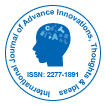Post-Quantum Cryptography: Securing the Future of Digital Communications
Received: 01-Oct-2024 / Manuscript No. jaiti-25-159245 / Editor assigned: 05-Oct-2024 / PreQC No. jaiti-25-159245(PQ) / Reviewed: 19-Oct-2024 / QC No. jaiti-25-159245 / Revised: 24-Oct-2024 / Manuscript No. jaiti-25-159245(R) / Published Date: 30-Oct-2024 QI No. / jaiti-25-159245
Abstract
Post-Quantum Cryptography (PQC) represents the forefront of cryptographic research, aimed at safeguarding data against the potential threats posed by quantum computing. With the anticipated rise of quantum computers capable of breaking traditional cryptographic systems, PQC seeks to develop encryption algorithms resilient to quantum attacks. This article explores the foundational principles of PQC, its potential applications, ongoing challenges, and future directions. By addressing both theoretical and practical aspects, we provide a comprehensive understanding of the role PQC will play in the evolution of secure digital communications.
Keywords
Post-Quantum Cryptography, quantum computing, encryption, quantum-resistant algorithms, cybersecurity, cryptographic standards, lattice-based cryptography, future-proof security.
Introduction
Quantum computing is poised to revolutionize computation by solving problems intractable for classical computers. While promising for many applications, quantum computing also poses a significant threat to cryptographic systems. Algorithms such as RSA, ECC, and DSA, which underpin much of today’s secure communication, are vulnerable to quantum attacks via Shor’s algorithm. Post-Quantum Cryptography (PQC) aims to develop quantum-resistant algorithms that ensure long-term data security, even in the presence of quantum adversaries [1, 2].
Principles of Post-Quantum Cryptography
PQC focuses on developing algorithms based on mathematical problems considered resistant to both classical and quantum attacks. The main categories include:
Lattice-Based Cryptography: Relies on problems like the Shortest Vector Problem (SVP) and Learning With Errors (LWE), which are computationally hard for both classical and quantum computers.
Code-Based Cryptography: Uses error-correcting codes, such as those in the McEliece cryptosystem, to provide quantum resistance.
Hash-Based Cryptography: Builds digital signature schemes using cryptographic hash functions.
Multivariate Polynomial Cryptography: Involves solving systems of multivariate polynomial equations over finite fields [3-5].
Isogeny-Based Cryptography: Leverages the hardness of computing isogenies between elliptic curves.
Applications of Post-Quantum Cryptography
PQC has a broad range of applications in securing digital infrastructure:
Secure Communication Protocols: Replacing traditional algorithms in protocols such as TLS, VPNs, and email encryption.
Blockchain Technology: Ensuring the immutability and security of blockchain systems in a quantum computing era. IoT Security: Implementing lightweight, quantum-resistant algorithms to protect IoT devices with limited computational resources. Cloud Security: Safeguarding data storage and processing in cloud environments against future quantum threats.
Challenges in Implementation
While promising, PQC faces several challenges:
Performance Overheads: Quantum-resistant algorithms often require more computational power and memory, impacting efficiency [6, 7].
Standardization: The ongoing efforts by organizations such as NIST aim to identify and standardize PQC algorithms suitable for widespread adoption.
Backward Compatibility: Transitioning to PQC must ensure compatibility with existing systems.
Key Management: Larger key sizes in many PQC schemes pose challenges for storage and transmission.
Future Directions
The development of PQC is an active area of research with several promising directions:
Algorithm Optimization: Enhancing the efficiency of PQC algorithms to minimize performance trade-offs.
Hybrid Cryptographic Systems: Combining traditional and quantum-resistant algorithms during the transition period [8-10].
Quantum-Safe Standards: Establishing global standards to facilitate consistent and secure implementation.
Education and Awareness: Promoting understanding of quantum threats and PQC solutions among stakeholders.
Conclusion
Post-Quantum Cryptography is essential for maintaining the security and integrity of digital communications in the quantum era. By focusing on quantum-resistant algorithms, addressing implementation challenges, and fostering global collaboration, PQC aims to create a secure foundation for future technological advancements. As quantum computing continues to evolve, the proactive development and adoption of PQC will ensure the resilience of our digital infrastructure.
References
- Bower H, Johnson S, Bangura MS, Kamara AJ, Kamara O, et al. (2016) . Emerg Infect Dis 22: 1403-1411.
- Brannan JM, He S, Howell KA, Prugar LI, Zhu W, et al. (2019) . Nat Commun 10: 105.
- Cross RW, Bornholdt ZA, Prasad AN, Geisbert JB, Borisevich V, et al. (2020) . Nat Commun 11: 3736.
- Henao-Restrepo AM, Camacho A, Longini IM, Watson CH, Edmunds WJ, et al. (2017) . Lancet Lond Engl 389: 505-518.
- Jacobs M, Aarons E, Bhagani S, Buchanan R, Cropley I, et al. (2015) . Lancet Infect Dis 15: 1300-1304.
- Ponsich A, Goutard F, Sorn S, Tarantola A (2016) . Acta Trop août 160: 62-67.
- Cantaert T, Borand L, Kergoat L, Leng C, Ung S, et al. (2019) . Lancet Infect Dis 19: 1355-1362.
- D'Souza AJ, Mar KD, Huang J, Majumdar S, Ford BM, et al. (2013) . J Pharm Sci 102: 454-461.
- Hopkins RJ, Howard C, Hunter-Stitt E, Kaptur PE, Pleune B, et al. (2014) Vaccine 32: 2217-2224.
- Longstreth J, Skiadopoulos MH, Hopkins RJ (2016) . Expert Rev Vaccines 15: 1467-1479.
, ,
, ,
, ,
, ,
, ,
, ,
, ,
, ,
, ,
, ,
Citation: Nikholas S (2024) Post-Quantum Cryptography: Securing the Future of Digital Communications. Int J Adv Innovat Thoughts Ideas, 12: 298
Copyright: © 2024 Nikholas S. This is an open-access article distributed under the terms of the Creative Commons Attribution License, which permits unrestricted use, distribution, and reproduction in any medium, provided the original author and source are credited.
Share This Article
Recommended Journals
51ºÚÁϳԹÏÍø Journals
Article Usage
- Total views: 408
- [From(publication date): 0-0 - May 02, 2025]
- Breakdown by view type
- HTML page views: 225
- PDF downloads: 183
